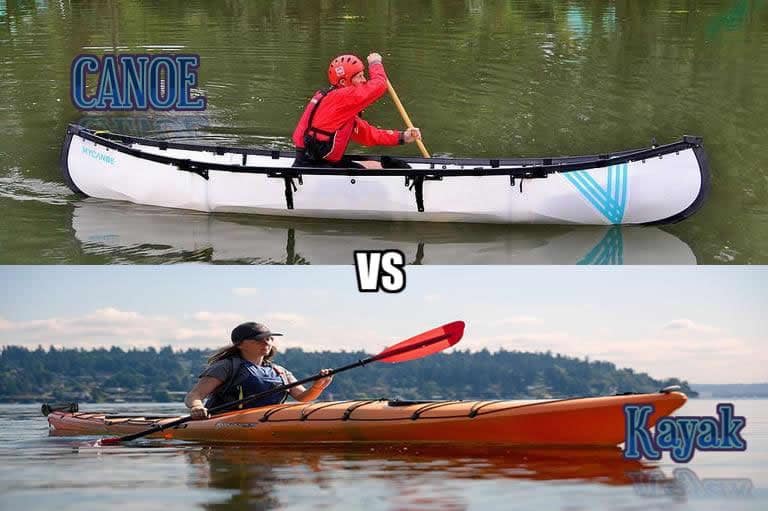Canoes are long boats with sharp edges known for their long, lean profiles. Compare that to a kayak, a smaller but still long and lean boat with one or more cockpits or openings. While both boats may look somewhat similar, there’s enough differences between them that some people staunchly prefer canoes over kayaks and vice-versa.
How do you know which of the two boats you should pick?
Contents
- Canoe Or Kayak. How To Identify The Best Boat For You
- Consideration 1. Understand What You Will Use The Boat For
- Consideration 2. Know Where You Will Use The Boat
- Consideration 3. Onboard Space Is An Important Consideration
- Consideration 4. Budget Can Affect Boat Choice
- How To Choose Between A Canoe And A Kayak
- The Pros And Cons Of Canoe Ownership
- The Pros and Cons of Kayak Ownership
- Conclusion: Kayak vs Canoe. Knowing Which Is A Better Boat For You
Canoe Or Kayak. How To Identify The Best Boat For You
A canoe is propelled with a single-sided paddle.
A kayak uses a double-sided paddle.
Canoes are slower but are easier to get in and out of and usually offer more storage space.
Modern kayaks have different hull options for specific applications with sit-in and sit-on options.
Kayaks are easier to upright if capsized.
Unfortunately choosing between a canoe and a kayak is not just a matter of comparing both boats like-for-like.
Both boats have different models with different hull types that have been designed for specific purposes and specific environments.
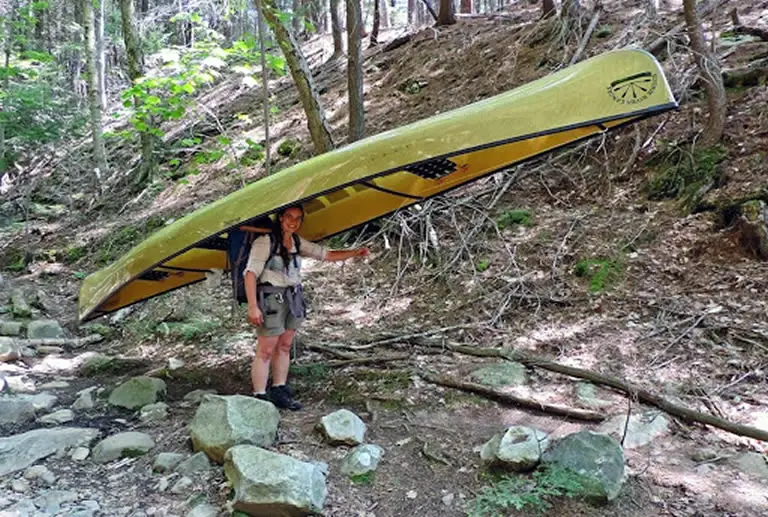
For example, a sea or touring kayak is completely different from a whitewater kayak and a tumblehome canoe has a different hull design to a flat bottom canoe.
There is usually a type of kayak and a type of canoe to suit most applications.
So, you must first determine which type of boat you need based on it’s hull design before you decide on which style of boat you prefer.
Four things to consider for finding your ideal boat
To get a better idea of what type of boat you need there are 4 basic questions you should as yourself.
Before you decide whether a canoe or a kayak is the best choice for you, it’s important to ask yourself the following four questions:
- What will you use your boat for?
- Where will you use your boat?
- How much deck space do you need?
- What is your budget?
As well as answering the above questions you should also carefully weigh the pros and cons of ownership of each boat, which we’ll do in this article.
By the time you’re done reading, you should hopefully have a better idea of which boat is a better fit for you and know exactly which hull type you need.
Consideration 1. Understand What You Will Use The Boat For
What do you ideally want to do in your boat? Do you wish to go whitewater boating or ride on a calm river?
Perhaps you want to take your boat out onto the ocean.
Maybe you are considering using your new boat for touring, utility work, hunting, or other recreational activities.
If the above activities appeal to you, we have some good news.
Both canoes and kayaks work well for these purposes.
However, be aware that there are different types of kayaks designed for different applications – just as there are canoes that incorporate different designs for different environments also.
Unfortunately, there is no one-boat-fits-all option available.
For example, a sea kayak is not good for whitewater rapids, where you would need a river kayak.
Likewise, a flat bottom canoe would perform poorly in choppy open water compared to a shallow-v canoe.
To understand the differences between modern kayak designs be sure to read this article.
The aforementioned article details which kayak design is best suited to specific applications such as calm water recreational use, or fishing, or hunting, or ocean use etc.
For a better understanding of the differences in designs used on modern canoes read this article.
The above linked article will help you better understand how the hull design of the boat affects its performance in different environments so you can tell which hull design is the fit for your needs.
The hull design of both boats affects their Primary and Secondary Stability which determines the best use of the boat and the most appropriate environment in which to use it.
To understand what primary and secondary stability is read this short explanation.
You absolutely must also know if you will you use your boat in turbulent waters or in calmer waters.
Not only can the wrong choice of boat design could take the fun out of boating for you but in extreme cases it could even be dangerous.
Consideration 2. Know Where You Will Use The Boat
Kayaks and canoes have great stability today thanks to their modern designs.
That means they can ride everything from tame bodies of water to cresting ocean currents and whitewater.
However, there is no one-boat-fits-all option.
Modern canoes and kayaks can be used in most water environments but there is no one-boat-fits-all option.
For example, an ocean kayak has a different design from a whitewater kayak and a tumblehome canoe has a different design from a flat bottom canoe.
When you identify the type of environment in which you will use your boat most often it becomes much easier to pick the most appropriate boat for your needs.
Boat uses & how they relate to the first 2 considerations
We should take this time to talk about the basic shapes and designs of both canoes and kayaks here to help you better understanding which vessel is better for you.

Let’s look at kayak designs first.
Basic kayak hull designs and their uses
Although manufacturers often mix and meld different hull shapes as they strive to create better boats you can think of modern kayaks as having four basic hull types.
As I mentioned above, modern kayak designs often tend to bleed into one and other. So, for ease of reading and to give you a good working knowledge of which kayaks are best for which activities, you can think of a kayak as having only one of the four basic hull designs.
The 4 basic hull designs of a kayak are as follows:
- Flat-bottomed
- Pontoon
- V-shape
- Rounded
Flat bottom
Flat-bottomed hulls can navigate very shallow bodies of water from rivers to canals, lakes, and other inland waterways as long as the water is calm.
They’re ideal for beginners as they have great primary stability.
Most recreational kayaks are flat bottomed with straight or almost straight sides to offer the novice paddler as much stability as possible.
However, this does not mean flat-bottomed kayaks are beginner boats!
Pontoon
If you’re familiar with the shape and size of a pontoon boat, then you’ll be aware of the basic shape. A pontoon kayak’s hull is not all that different.
Like the boat they’re named after, these kayaks have awesome stability.
This stability comes at the cost of speed though.
These kayaks are slow compared to other types.
You will often see pontoon kayaks used for fishing, recreational use and in open waters.
V-hull
Do you plan on riding in the ocean or in turbulent waters?
Then you’ll likely want a boat with this hull design.
A kayak with a v-hull has a shape that allows the boat to chop through rougher waters.
It’s somewhat less stable than the other hull types on calm water, though.
Rounded hull
You might also consider a kayak with a rounded hull.
A rounded hull offers great secondary stability and lets you maneuver exceptionally well on the water.
You’ll also go faster, but you tend to have less primary stability.
These type of kayaks are often used in rivers with whitewater rapids and are sometimes used as surfing kayaks.
They feel “tippy” but are actually difficult to tip.
A word about chine & rocker
The basic roundness of the bottom of a kayak is referred to as chine and as you have seen from the above information it affects how and where a kayak is used.
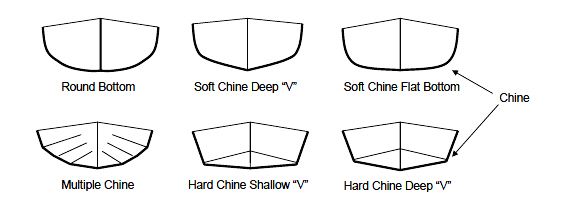
The roundness of the sides of a kayak is referred to as rocker.
You can read more about that here.
Sit-in vs sit-on-top kayaks
Before we take a look at canoe designs I should mention that there are 2 different types of kayak in regards to how you ride in one.
This is such a large topic that it deserves its own post. However it deserves a mention and quick explanation here.
A sit-in kayak has a cockpit that accommodates the paddler and is often covered with a fabric deck (to keep out the water).
These are the most common type of kayaks you will see being used for recreational purposes (at least where I come from).
When kayaking in whitewater and other turbulent waterways sit-in kayaks are by far the best choice.
A sit-on-top kayak has a different deck design with one or two seats that sit on an open deck.
This means a sit-on-top kayak usually offers more room for storage.
This gear will also be within easy reach of the paddler even when seated.
Although smaller one-person sit-in kayaks do not offer as much storage space as their sit-on-top cousins, touring or ocean kayaks (which are sit-in) will have large enclosed compartments.
Larger ocean kayaks do offer a lot of space for gear but it is not easily accessible while you are in the boat.
Propulsion
A kayak is more often than not is propelled by a double-sided paddle.
However, larger kayaks are sometimes fitted with an outboard engine as shown in the video below.
More often than not they are fitted to sit-on kayaks rather than sit-in models.
Be aware that a canoe can also be fitted an outboard engine though the bow will tend to lift significantly out of the water.
Sides
Although there are also differences in the sides of a kayak (the rocker), as I outlined here, the above information should give you a basic understanding of which type of kayak would be a better fit for you.
So that covers the basics of kayaks.
What about canoes?
Basic canoe hull designs and their uses
Like kayaks canoes have different hull types as well.
The 4 basic types of canoe are:
- Round bottom
- Flat bottom
- Shallow arch
- Shallow-V
Round bottom
Of the four hull types you’ll likely come across rounded-bottomed canoes the least often.
A round-bottomed canoe has a shape that lends the boat well to more turbulent waters as it offers excellent secondary stability.
However this extra stability in choppy waters means it has less primary stability and so can feel tippy in calm water.
Rounded canoes are usually faster than other types making them great for competitions and races.
Flat bottom
Flat-bottomed canoes maneuver well and stay stable if you don’t venture out of calm waters.
In rougher waters like oceans, and even some turbulent rivers and windy lakes, you won’t get around very well in a flat bottom canoe.
Adding more weight to the boat – from passengers, gear, or cargo – will also reduce stability.
However, in calm lakes, rivers and canals a flat bottom canoe is exceptionally stable and is a great recreational vessel for family outings.
Shallow arch
A canoe with a shallow arch hull will help you paddle better in gentler waters as it offers a combination of fairly good primary stability with fairly good secondary stability.
It compromises between the two to give a good all-round boat.
Thistype of hybrid design means a shallow arch canoe is almost as good in calm water as a flat-bottomed canoe while offering much more stability such as when the waters become choppy.
Shallow-v
Last, there’s the shallow-v canoe.
On this type of canoe you get pretty good stability like you would with a flat-bottomed canoe, but this boat can switch between choppy and calm waters without much difficulty.
That said, don’t take that stability for granted.
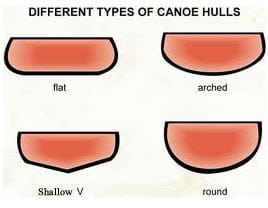
With a deeper draft than other canoe types, if you catch on debris or rocks when riding very shallower waters, you could risk tipping over and/or damaging your boat.
If you want a deeper understanding of how these hull designs affect a canoes performance and which ones are best suited for specific applications read this article. That article also includes a section about the design of the boat’s sides (straight, flared and tumblehome).
Consideration 3. Onboard Space Is An Important Consideration
Another key consideration when choosing between a kayak and a canoe is deck space.
Although large sit-on kayaks do offer pretty good deck space, as a rule-of-thumb you will get more space in a canoe.
You can also stand up in a canoe which is much more difficult to do in a sit-on-top kayak, and downright impossible in a sit-in kayak.
If you plan on fishing and hunting you will likely be bringing a lot of gear with you and will therefore probably prefer either a canoe or sit-on-top kayak.
You may need room for gear
A sit-in kayak will never offer the same amount of space for gear as a canoe unless you have a very large sea touring kayak designed for long journeys.
Most site-in kayaks just don’t offer the same type of storage space as a canoe.
Having said that a large sit-on-top kayak, such as a fishing kayak, will offer plenty of space for gear. But be aware that a canoe will still always have more deck space to allow you to move about while onboard.
How many people will be onboard?
Next, you have to consider how many people you will want to bring with you on your boating adventures.
While it certainly varies from model to model, most medium to large canoes can fit up to four adults.
If you have kids, you can bring four of them with two adults, increasing the passenger count to six.
As a canoe has a open deck area the only limitation on the number of passengers it can hold (within reason) is the boat’s weight capacity.
As for kayaks, these streamlined vessels often have less space for passengers.
However, even a more roomy sit-on-top kayak will have much less deck space than an equivalent sized canoe.
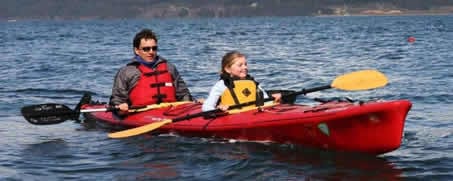
For sit-in kayaks with an enclosed cockpit there are family sized boats that cater to 2 or more paddlers.
These are most often seen in sea or touring kayaks. Some kayaks can fit only one child and two adults.
For the most part if you plan to boat in a group of 2 or more people a canoe will be a better choice.
Bringing dogs on a kayak
Although paddlers can, and do, take their dogs with them on a sit-in kayak (usually putting the animal in one of the compartments with the lid removed) it is much more common to carry animals on a sit-on kayak due to the extra deck room.
Bringing dogs on a canoe
A canoe can easily accommodate one or more dogs.
The open deck design of a canoe tends to lend itself more to bringing dogs on the water though there are many kayak owners who would argue differently.
If I planned to bring more than one dog onto the water, and with everything else being equal, I would opt for a canoe – but this is purely a personal choice.
There are always exceptions.
Consideration 4. Budget Can Affect Boat Choice
Arguably, one of the biggest deciding factors that sways people when making a purchasing decision is price.
If one of these boats costs more than its equivalent alternative you might choose the other because it’s cheaper.
This brings us to the question of which of the two boats has the bigger price tag?
It seems that regardless of whether you want a canoe or a kayak, if you want to go for a top-end boat you’re still going to spend some semi-serious money.
At the upper-end of the market the cost between canoes and kayaks is marginal.
However, when you get to the lower end of the spectrum a one-person hard plastic kayak is considerably cheaper than the cheapest hard shell canoe. This is usually because the kayak will be much smaller.
Inflatable kayaks and inflatable canoes are very reasonably priced and a great way to get onto the water cheaply.
These inflatable boats can be purchased for less than $100.
Let’s look at two example retailers that offer fairly good prices on both boat types to compare prices between a kayak and a canoe.
Examples from 2 retailers
Below are some example prices from 2 different sellers that offer pretty good deals on both kayaks and canoes.
Although prices will vary between sellers, sometimes quite strikingly, the examples below will give you some indication of the type of prices for these boats.
Always shop around before you make a purchase as you may find a boat has drastically different price tags in different stores.
Amazon kayaks & canoes
Looking at kayaks on Amazon for example, the average price for a one-person plastic kayak seems to be about $300 to $400.
These boats are more than capable of taking abuse and are very good value for money.
Higher-end models are usually around the $700+ mark.
Of course inflatable kayaks are available and are considerably cheaper with models starting as low as 60 dollars.
Although the choice is limited, canoes appear to be fairly cheap on Amazon, like this 14 foot Sun Dolphin Scout kayak.
Sun Dolphin also make a really good cheap 10 foot recreational kayak.
Sun Dolphin is a great brand for novices who have not yet decided on the exact boat models that they like best due to inexperience on the water. They are also very cheap.
Cabela kayaks & canoes
What if you were shopping at Cabela’s?
Canoes at Cebela vary in price. The lowest-priced canoe on that retailer’s website would set you back about $650. The more expensive models cost up to $1,200.
As for kayaks at Cabela’s, you can get one for under $200. It might not be the best boat in the world, but hey, it’ll get you on the water.
The more expensive ones are $1,000 to $3,000.
While there are price outliers for both canoes and kayaks, it seems pretty clear that kayaks are the more inexpensive pick of the two at the lower-end of the market.
How To Choose Between A Canoe And A Kayak
So which boat is a better fit for you?
Reviewing the above information it may seem a little overwhelming and difficult to know which boat is better for you.
So below I’ve outlined a few pros and cons of owning each boat type to help you better understand.
Just keep in mind that you can be sure that there is both a canoe and a kayak out there that will fit your needs.
This is regardless of whether you want a hunting boat, a fishing boat or just something to cruise down the river in with family and friends.
The choice will usually come down to personal preference.
In the next two sections, we’ll discuss the pros and cons of both canoes and kayaks.
Be aware that the advantages and disadvantages I mention here are generic in nature.
There are so many different designs and models available for both canoes and kayaks that it is easy for an experienced paddler to argue for and against each point made in this post.
However, the guidance given is good for most store bought boats that you will consider buying.
The Pros And Cons Of Canoe Ownership
Owning a canoe comes with a lot of advantages over a kayak. Here are a few.
The pros of a canoe
Since canoes have more open interior space than a kayak, that often means you can bring more passengers with you including your dogs.
You also usually have the room for more gear and equipment.
Basically, although there are kayaks that can store large amounts of gear for the most part a canoe will have more room.
Do you have a long canoeing trip planned? Then you’ll love how you’re not stuck in just one spot in a canoe.
You can turn, maneuver yourself on the boat, and reposition your seating as necessary since canoes have wide open seating arrangements.
You can even stand if you so wish (although you maybe shouldn’t do this if you’re a beginner).
Canoes are also usually easier to maneuver on the water than kayaks.
They are great for camping and long journeys due to their roominess for gear and the ability to move about on the boat.
A canoe is very easy to get in and out of.
They also look awesome!
The cons of a canoe
Okay, so canoes are great but what about the cons of owning one?
For one, you can achieve a higher speed in a kayak compared to a canoe.
Their double sculls don’t work as well as the single or double paddles that come equipped with a kayak.
If you’re the only one riding in a large canoe then you’re going to find you pretty much get a full-body workout.
I know some people will argue with this but most canoes are heavier than kayaks and so they require more energy to move them.
Of course this does not apply to inflatables.
Although some canoes can be used in open water they are less desirable for ocean use than a sea kayak for example.
A canoe is very difficult to right if you capsize especially in you are on your own.
The Pros and Cons of Kayak Ownership
What about kayaks? Kayaks offer a lot of advantages over canoes.
Here are a few.
The pros of a kayak
As I mentioned before kayaks travel more quickly in the water.
This has to do with their stern and bow shape and design.
A kayak will almost always have a shallower draft than a canoe especially the larger vessels.
This makes it easier to paddle and thus achieve greater speeds.
Since you tuck your gear and belongings in the gaps between the openings of a kayak, or into sealed compartments none of your stuff should get wet.
Larger kayaks have fairly large compartments also with watertight lids.
When it comes to the smaller boats their lighter-weight profiles means you can easily bring your kayak with you just about anywhere even carrying it over land.
Touring kayaks are great for long journeys and camping breaks and are capable of ocean use.
Kayaks are very easy to flip topside when they are capsized.
So much so that rolling a kayak, as I demonstrated how to do here, is a must-do activity at least once for everyone who gets in one.
The cons of a kayak
As for the downsides, you don’t get nearly as much room to maneuver onboard and switch seating in a kayak as you do in a canoe.
Once you sit down, you’re kind of stuck in your seat for a while.
For the most part there is less storage space in a kayak than in a canoe.
Gear in a kayak is not as easily accessible especially in a sit-in canoe where you will only be able to access the compartments when you are no longer in the water.
Of course in a sit-on-top kayak your gear will on the open deck but it is still not as easy to get to as it would be in a canoe where you can stand up and move around.
If you plan to take your dog or multiple dogs with you on your kayak then you will need to opt for a sit-on-top kayak.
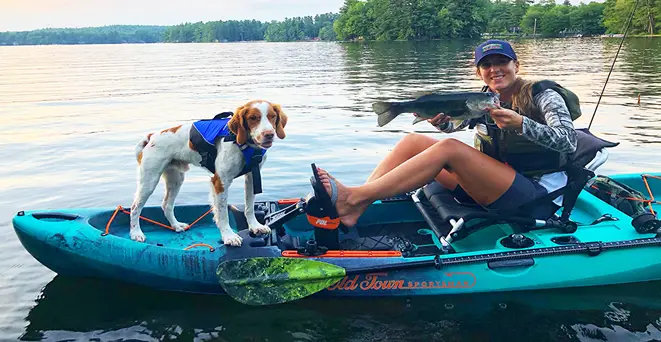
These are usually more expensive than a sit-in kayak and has more restrictions on the its use – a sit-on-top kayak is not a good choice for turbulent waters.
If you use double paddles, then you might be surprised by their heavier weight.
You also tend to get wetter with double-bladed paddles as the water drips down the paddles (single paddles don’t get raised high for water to drip down).
There’s more of a learning curve associated with using a kayak than a canoe especially the ones that lean more towards secondary stability as they feel tippy.
They are also usually less maneuverable than a canoe, though models differ of course.
It is also much more difficult to get into and out of a kayak.
Still, once you know what you’re doing, you can have a great time in one of these boats.
If you decide to buy a sit-in kayak be sure to the read this article that outlines how to choose the best one.
Conclusion: Kayak vs Canoe. Knowing Which Is A Better Boat For You
Canoes and kayaks have similar shapes and design profiles, but there’s also major differences between these two boats.
- With a canoe, you have a much wider interior with lots of room for stashing gear.
- Sit-in kayaks have smaller openings and less storage, but your gear stays drier.
- You can move a lot faster in a kayak but a canoe is easier to maneuver.
- Sit-on-top kayaks offer an open deck space but still offer less room than a canoe.
- Dogs can be taken on either boat though a canoe is better equipped to handle the extra passengers.
How do you choose between the two?
Consider the factors discussed in this article. Figure out which factors are most important to you and then use them to guide your decision.
Either way, you can’t really go wrong with either boat!
If you are still unsure of which boat type is best for you after a lot of research on the subject then I advise you to get a very cheap inflatable canoe and a very cheap inflatable kayak.
Try out each one in the same waters to see which one you prefer.
This is a very cheap way of deciding on the best boat for you and you can do it for under $200!

